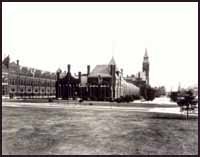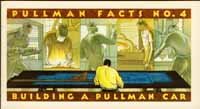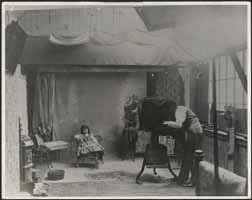Arthur E. Stilwell
You are at Home -> The Pullman Company -> Arthur E. StilwellThe Lowly Oyster
In the 19th century, much effort was made in the transport of the lowly oyster, bivalve mollusks of the family Ostreidae. Oysters were once considered a great delicacy in the United States, and their salt-water origins made them difficult to acquire and expensive throughout much of the country. Because of their scarcity and the subsequent high prices that they commanded, much effort was made in transporting them into the interior of America. Indeed, one of the industries touted by the Chicago Tribune (Jan. 7. 1883) of being of national importance was Chicago's huge capacity for receiving, housing, and distributing oysters from the east coast. Such was the economic importance of the oyster market that accounts of train accidents of the time specifically mention the loss of the oyster car, sometimes even before casualties are listed. The New York Times (Dec. 11, 1854) wrote, On Friday last a train on the Central Ohio Railroad was thrown off the track, the engineer killed, and a fireman fatally injured. The locomotive, baggage, and an oyster car, were smashed to pieces, but fortunately none of the passengers were injured. On Oct. 23, 1883, the New York Times wrote about a train crash: The oyster car was crushed, and all of the other cars more or less injured, but the passengers escaped unhurt. Various cars and schemes were developed for the purpose of transporting live, fresh oysters; however, all of the cars proved inadequate. Whole carloads arrived dead, succumbing to problems with salinity, temperature, and disease. Enter the design of Arthur E. Stilwell, inventor of the famed Stilwell Oyster Car and railroad tycoon. Stilwell came up with an ingenious car design which became an immediate best-seller, commissioned and manufactured by the Pullman Company.

The Stilwell Oyster Car |

The Patent for the Oyster Car |

Article about the car, Chicago Tribune, February 27, 1898 |
Arthur E. Stilwell

Arthur E. Stilwell
THE PULLMAN HISTORY SITE

More Information About the Pullman Company
Products from the Factory
Edison Films of Pullman Travel

From A Romance of the Rail, 1903
Other Pullman-Related Sites
- Historic Pullman Garden Club - An all-volunteer group that are the current stewards of many of the public green spaces in Pullman. (http://www.hpgc.org/
- Historic Pullman Foundation - The HPF is a non-profit organization whose mission is to "facilitate the preservation and restoration of original structures within the Town of Pullman and to promote public awareness of the significance of Pullman as one of the nation's first planned industrial communities, now a designated City of Chicago, State of Illinois and National landmark district." (http://www.pullmanil.org/)
- The National A. Philip Randolph Pullman Porter Museum is a 501(c)3 cultural institution. Its purpose is to honor, preserving present and interpreting the legacy of A. Philip Randolph, Pullman Porters, the Brotherhood of Sleeping Car Porters and the contributions made by African-Americans to America's labor movement. ((http://www.nationalpullmanportermuseum.com/)
- Pullman Civic Organization - The PCO is a strong and vibrant Community Organization that has been in existence since 1960. (http://www.pullmancivic.org/)
- Pullman National Monument - The official page of the Pullman National Park. (https://www.nps.gov/pull/)
- South Suburban Genealogical & Historical Society - SSG&HS holds the Pullman Collection, consisting of personnel records from Pullman Car Works circa 1900-1949. There are approximately 200,000 individuals represented in the collection. (https://ssghs.org/)
- The Industrial Heritage Archives of Chicago's Calumet Region is an online museum of images that commemorates and celebrates the historic industries and workers of the region, made possible by a Library Services and Technology Act grant administered by the Illinois State Library. (http://www.pullman-museum.org/ihaccr/)
- Illinois Digital Archives (IDA) is a repository for the digital collections libraries and cultural institutions in the State of Illinois and the hosting service for the online images on this site. (http://www.idaillinois.org/)







